#Mythtory
Explore tagged Tumblr posts
Text
Historical Holiday Traditions We Really Need To Bring Back
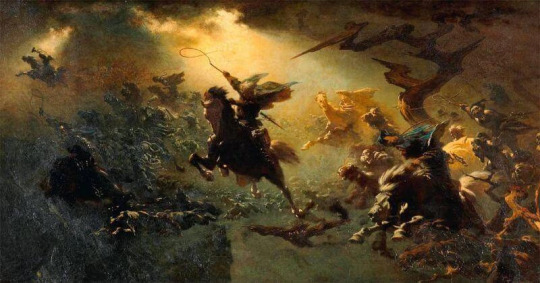
Here comes Santa Claus, and also a bunch of annual holiday Things we do to ensure he commits a truly boggling act of breaking and entering and leaves goods underneath the large plant in the living room.
Because I’ve always got a hankerin’ for the days of yore, here are some historical holiday traditions we really need to bring back:
1. Everything that happened on Saturnalia
Saturnalia was the ancient Roman winter festival held on December 25th--which is why we celebrate Christmas on that day and not on the day historians speculate Jesus was actually born, which was probably in the spring.
Saturnalia was bonkers. As the name suggests, it celebrated the god Saturn, who represented wealth and liberty and generally having a great time.
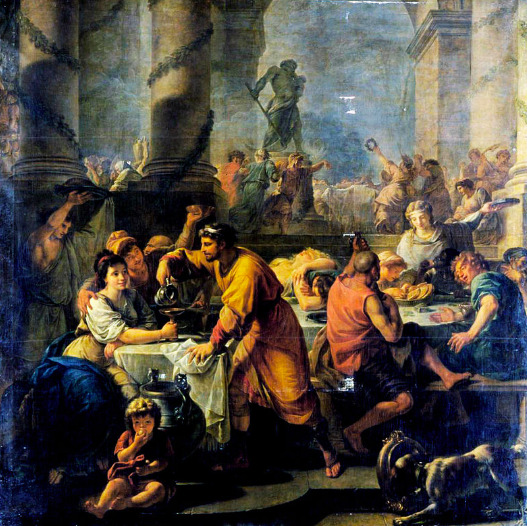
Above: Their party is way cooler than yours could ever hope to be.
During Saturnalia, masters would serve their slaves, because it was the one day during the year when everybody agreed that freedom for all is great, actually, let’s just do that. Everyone wore a coned hat called the pilleus to denote that they were all bros and equal, and also to disguise the fact that they hadn’t brushed their hair after partying hard all week, probably.
Gambling was allowed on Saturnalia, so all of Rome basically turned into ancient Vegas, complete with Caesar’s Palace, except with the actual Caesar and his palace because he was, you know. Alive.
The most famous part (besides getting drunk off your rocker) was gift-giving--usually gag gifts. Historians have records of people giving each other some truly impressive white elephant gifts for Saturnalia, including: a parrot, balls, toothpicks, a pig, one single sausage, spoons, and deliberately awful books of poetry.
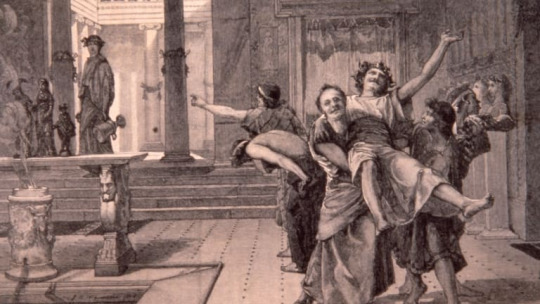
Above: Me, except all the time.
Partygoers also crowned a King of Saturnalia, which was a predecessor to the King of Fools popular in medieval festivals. The king was basically the head idiot who delivered absurd commands to everyone there, like, “Sing naked!” or “run around screaming for an hour,” or “slap your butt cheeks real hard in front of your crush; DO IT, Brutus.”
Oh, wait. Everyone was already doing all that. Hell yes.
(Quick clarification: early celebrations of Saturnalia did feature human sacrifice, so let’s just leave that bit out and instead wear the pointy hats and sing naked, okay? Io Saturnalia, everybody.)
2. Leaving out treats for Sleipnir in the hopes of avoiding Odin’s complete disregard for your property
The whole “leave out cookies and milk for Santa” thing comes from a much older tradition of trying to appease old guys with white beards. In Norse mythology, Odin, who was sort of the head god but preferred to be on a perpetual road trip instead, took an annual nighttime ride through the winter sky called the Wild Hunt.
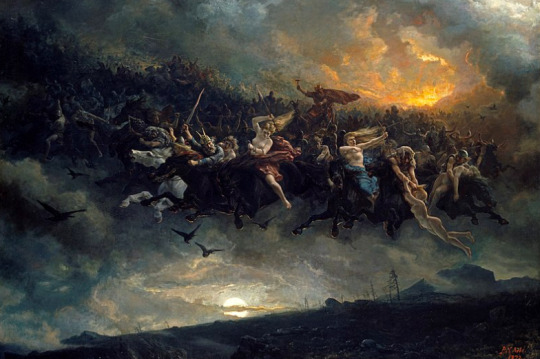
Above: The holidays, now with 300% more heavy metal.
Variations of the Wild Hunt story exist in a bunch of European folklore--in Odin’s case, he usually brought along a bunch of supernatural buddies, like spirits and other gods and Valkyries and ghost dogs, who, the Vikings said, you could hear howling and barking as the group approached (GOOD DOGGOS).
That was the thing, though; you never actually saw Odin’s hunt--you only heard it. And hearing it did not spark the same sense of childish glee you felt when you thought you heard Santa’s sleigh bells approaching as a kid--instead, the Vikings said, you should be afraid. Be VERY afraid.
Because Odin could be kind of a dick.
Odin was also known as the Allfather, and like any father, he hated asking for directions. GPS who? I’m the Allfather, I’m riding the same way I always ride.
And that was pretty much it: “I took this road last year and I’m taking it again this year.”
“But,” someone would pipe up from the back, “there are houses on the road now--we’re gonna run right into them. We could just take a different path; there’s actually a detour off the--”
“Nope,” Odin would say. “They know the rules. My road, my hunt, my rules. We’re going this way.”
So if you were unlucky enough to have built your house along one of Odin’s favorite road trip sky-ways, he wouldn’t just plow right past you.
He would burn your entire house down--and your family along with it.
Kids playing in the yard? Torch ‘em; they should have known better. Grandma knitting while she waits for her gingerbread Einherjar to finish baking? Sucks to be her; my road, my rules, my beard, I’m the Allfather, bitch.
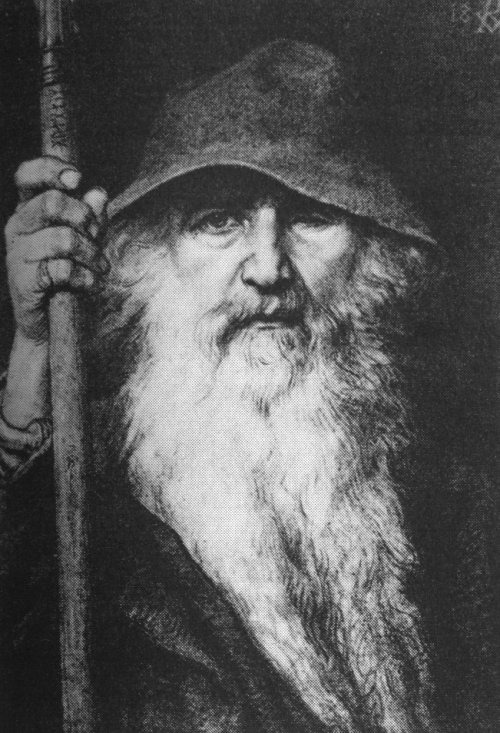
Above: Santa, but so much worse.
To be fair to Odin, he could be a cool guy sometimes. He just turned into any dad when he was on a road trip and wanted to MAKE GOOD TIME, DAMN IT, I AM NOT STOPPING; YOU SHOULD HAVE PEED BEFORE WE LEFT.
To ensure they didn’t incur Odin’s road trip wrath, the Vikings had a few ways of smoothing things over with Dad.
They would leave Odin offerings on the road, like pieces of steel (??? okay ???) or bread for his dogs, or food for his giant, eight-legged horse, Sleipnir, because the only true way to a man’s heart is through his pet.
People would generally leave veggies and oats and other horse-y things out for Sleipnir, whose eight legs made him the fastest flying horse in the world and also made him the only horse to ever win Asgard’s coveted tap dancing championship.
(Side note: EIGHT legs...EIGHT tiny reindeer...eh? Eh? See how we got here? Thanks, nightmare horse!)

Above: An excellent prancer AND dancer.
And if Odin was feeling particularly charitable and not in the mood for horrific acts of arson, children would also leave their shoes out for him--it was said that he’d put gifts in your boots to ring in a happy new year.
If all that didn’t work and the Vikings heard the hunt approaching, they would resort to throwing themselves on the ground and covering their heads while the massive party sped above them like a giant Halloween rager.
So this holiday season, leave your boots out for Odin and some carrots out for his giant spider horse or you and your entire family will die in a fiery inferno, the end.
3. Yule Logs
Speaking of Scandinavia, another Northern European winter solstice tradition was the yule log. Today, if you google “yule log,” something like this will pop up:

...which isn’t an actual log, but is instead log-shaped food that you shove into your mouth along with 500 other cakes at the same time because it’s CHRISTMAS, and I’m having ME TIME; so WHAT if I ate the whole jar of Nutella by myself, alone, in the dark at 3 am?
But that log cake is actually inspired by actual logs of yore that Celtic, Germanic, and Scandinavian peoples decorated with fragrant plants like holly, ivy, pinecones, and other Stuff That Smells Nice before tossing the log into the fire.
This served a few purposes:
It smelled nice, and Bath and Body Works scented candles hadn’t been invented yet.
It had religious and/or spiritual significance as a way to mark the winter solstice.
It was a symbolic way of ringing in the new year and kicking out the old.
Common belief held that the ashes of a yule log could ward off lightning strikes and bad energy.
Winter cold. Fire warm.
Everybody loves to watch things burn. (See: Odin.)
The yule log cakes we eat today got their start in 19th century Paris, when bakers thought it was a cute idea to resurrect an ancient pagan tradition in the form of a delicious dessert, and boy, howdy, were they right.
In any case, I’m 100% down with eating a chocolate yule log while burning an actual yule log in my backyard because everybody loves to watch things burn; winter cold, fire warm; and hnnnngggg pine tree smell hnnnnggg.
(Quick note: The word “yule” is the name of a traditional pagan winter festival, still celebrated culturally or religiously in modern pagan practice. It’s also another name for Odin. He had a bunch of other names, one of the most well-known being jólfaðr, which is Old Norse for “Yule father.” If you would like to royally piss him off, or if you are Loki, feel free to call him “Yule Daddy.”)
4. Upside down Christmas trees
I just found out that apparently, upside down Christmas trees are a hot new trend with HGTV types this year, so I guess this is one historical trend we did bring back, meaning it doesn’t really belong on this list, but I’m gonna talk about it, anyway.

Side note: Oh, my god, that BANNISTER. I NEED.
Historians aren’t actually sure where the inverted Christmas tree thing came from, but we know people were bringing home trees and then hanging them upside down in the living room as early as the 7th century. We have a couple theories as to why people turned trees on their heads:
Logistically, it’s way easier to hang a giant pine tree from your rafters upside down by its trunk and roots. You just hoist that baby up there, wind some rope around the rafter and the trunk, and boom. Start decorating.
A Christian tradition says that one day in the 7th century, a Benedictine monk named Saint Boniface stumbled across a group of pagans worshipping an oak tree. So, instead of minding his own damn business, he cut the tree down and replaced it with a fir tree. While the pagans were like, “Dude, what the hell?” Boniface used the triangular shape of the fir tree to explain the concept of the holy trinity to the pagans. Some versions have him planting it right-side up, others having him displaying a fir tree upside down. Either way, it’s still a triangle that’s a solid but ultimately very rude way of explaining God. Word’s still out on whether anyone was converted or just rightly pissed off that this random guy strolled into their place of worship, chopped down their sacred tree, and plopped HIS tree down instead. Please do not do that this holiday season.
Eastern Europeans lay claim to the upside-down tree phenomenon with a tradition called podłazniczek in Poland--people hung the tree from the ceiling and decorated it with fruits and nuts and seeds and ribbons and other festive doodads.

(God, who lives in these houses? Look at that. That’s like a swanky version of Gaston’s hunting lodge. Where do I get one? Which enchanted castle do I have to stumble into to chill out in a Christmas living room like that?)
Today, at least in the West, upside-down trees are making a comeback because...I don’t know. Chip and Joanna Gaines said so.
Some folks say it’s a surefire way to keep your cats from clawing their way through the tree and then puking up fir needles for weeks afterward, which checks out for me.
5. Incredibly weird Victorian Christmas cards
So back in the 19th century, the Christmas card industry was really getting fired up. Victorians loved their mail, let me tell you. They loved sending it. They loved getting it. They loved writing it. They loved opening it. They loved those sexy wax seals you use to keep all that sweet, sweet mail inside that sizzling envelope. (Those things are incredibly sexy. Have you ever made a wax seal? Oh, man, it’s hot.)
The problem, though, was that while the Victorians arguably helped standardize many of the holiday traditions we know and love today (Christmas trees, caroling, Dickens everything, spending too much money, etc.) back in 1800-whenever, a lot of that Christmas symbolism was, um...still under construction. No one had really agreed on which visual holiday cues worked and which...didn’t.
Meaning everyone just kind of made up their own holiday symbols. Which resulted in monstrous aberrations like this card:
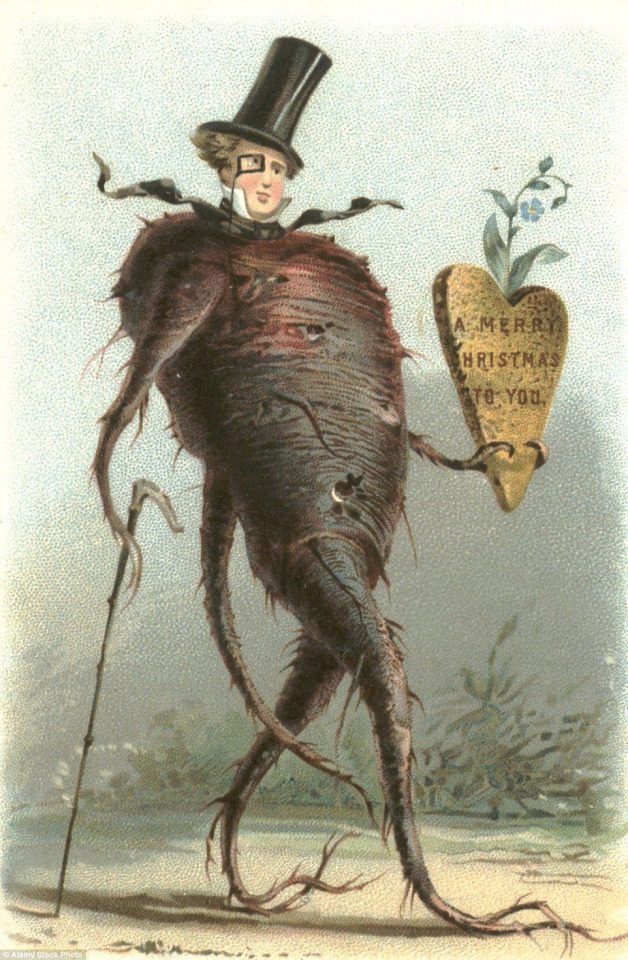
What the hell is that? A beet? Is that a beet? Or a turnip? Why is it...oh, God, why does it have a man’s head? Why does the man beet have insect claws?
What is it that he’s holding? A cookie? Cardboard? A terra cotta planter?
And then there’s this one:
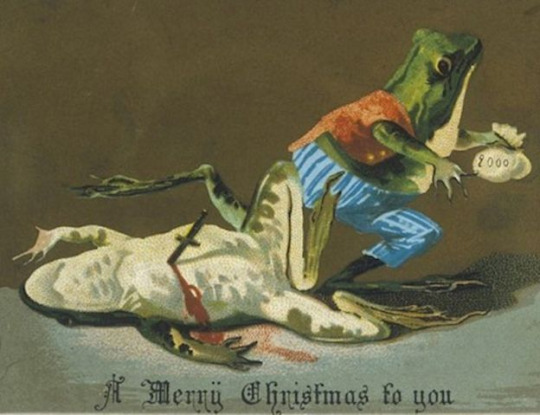
“A Merry Christmas to you,” it says, while depicting a brutal frog murder/mugging.
What are you trying to tell me? Are you threatening me with this card? Is that it? Is this a threat? How the hell am I supposed to interpret this? “Merry Christmas, hide your money or you’re dead, you stupid bitch.”
Also, why is the dead frog naked? Did the other frog steal his clothes after the murder? WHAT AM I SUPPOSED TO DO WITH THIS?
Victorian holiday cards also doubled as early absurdist Internet memes, apparently, because how else do I explain this?

Is this some sort of tiny animal Santa? A mouse riding a lobster? Like, the mouse, I get. Mice are fine. Disney built an empire on a mouse. And look, he’s got a little list of things he’s presumably going to bring you: Peace, joy, health, happiness. (In French. Oh, wait, is that that Patton Oswalt rat?)
But a LOBSTER? What’s with the lobster? It’s basically a sea scorpion. Why in the name of all that is good and holy would you saddle up a LOBSTER? I hate it. I hate it so, so much. Just scurrying around the floor with more legs than are strictly necessary, smelling like the seafood section of Smith’s, snapping its giant claws.
This whole card is a health inspector’s worst nightmare. It really is.
I gotta say, though, I am a fan of this one:
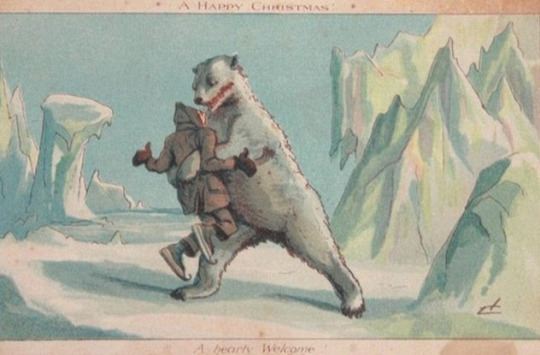
Presumably, that polar bear is going in for a hug because nothing stamps out a polar bear’s innate desire to rip your face from your skull than candy canes and Coke and Christmas spirit.
This next one is actually fantastic, but for all the wrong reasons:
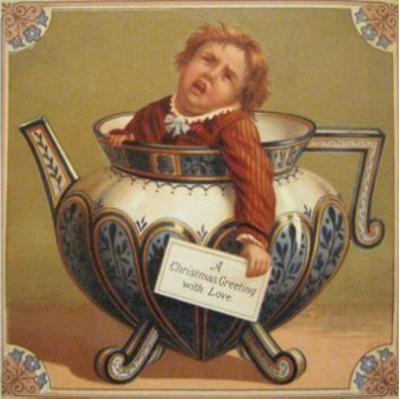
I know everyone overuses “same” these days but geez, LOOK at that kid. I can HEAR it. SAME.
If you’ve ever been in a shopping mall stuffed with kids, nothing sums it up better than this card. This is like the perverse version of those Anne Geddes portraits that were everywhere in the late 90s. “Make wee Jacob sit in the tea pot; everyone will--Jacob, STOP, look at Mommy; I said LOOK. AT. MOMMY--everyone will love it.”
Actually, you know what? Every other Christmas card is cancelled. This is the only card we will be using from now on. This is it.
Wait, no. We can also use this one:
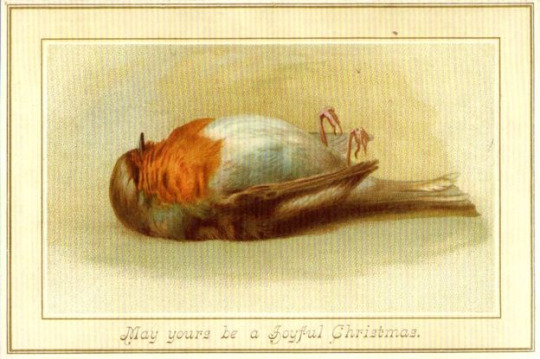
Merry Christmas. Here’s a fuckin’...just a dead fuckin’ bird.
2K notes
·
View notes
Text
Myth Time: Loki and the Goat

Once upon a time, the ice giantess/goddess/resident “I-have-no-indoor-voice friend” Skadi was upset about Asgard killing her dad, so she kicked down the door to their victory party and went, “WHO’S THE LITTLE PISSANT WHO KILLED MY FATHER?”
Everyone just stared, mouths full of feast food, and pointed to Loki like

And Loki went

Skadi glowered, axe in hand and went, “If you people don’t FIX this IMMEDIATELY, heads will roll, and by heads, I specifically mean--” and she swung her head in a certain jötunn’s direction-- “that head.”
And Loki was like

Odin immediately went into PR cleanup mode and said, “You’re right--we’re either advertently or inadvertently responsible for the death of your father. What is it that you want?”
And Skadi leaned in and hissed between her teeth, “I want blood.”
Odin, who generally preferred to be literally anywhere else about 95% of the time, went

and said, “Right, well, we’re in the middle of something right now, so besides bloodshed, what can we do to make reparations?”
Skadi narrowed her eyes. Sniffed. Looked around imperiously at the idiots with mouths full of mutton, and said, “I want three things.”
“Name them,” Odin said.
Skadi propped her axe against the wall, straightened up, and looked down at Odin through her frosted eyelashes.
“One,” she said, “I want you to cast my father’s eyes into the sky so they will be immortalized as eternal, shining stars.”
Odin went

but did it, anyway, because everyone’s got their quirks; who was he to judge?
Then, brushing the eyeball goo off of his hands, Odin asked, “What’s the second thing?”
Skadi sniffed.
“Secondly, I demand that one of you makes me laugh.”
The gods shifted in their seats. If they weren’t nervous before, they absolutely were now, because Skadi never laughed. Like, ever.
“Skadi never laughs,” Thor muttered in disbelief. “Like, ever.”
Skadi’s head swiveled in his direction. “Did you say something, you walking sausage roll?”
Thor quickly swallowed the bite of pie he’d been chewing. “No, no. Nothing.”
“My liege lady,” Odin said quickly, his tone suddenly silken. “Why not something...simpler? We wouldn’t want to insult you with lukewarm attempts at humor, after all--”
“Someone,” Skadi declared imperiously, “had better make me laugh, or I swear by the Norns, I will garrote each and every one of you with your own intestines while your children watch on the sidelines and weep for their gutless progenitors!”
Thor blinked and went,

But they had no choice. So, sweating slightly and fighting back anxiety pee, the gods each took their turn trying to make Skadi laugh.
Tyr, the god of war, tried some biting political satire. Skadi didn’t even blink.
Idunn, the goddess of youth, rattled off a few celebrity impressions, but was really more of a “behind the scenes” sort of gal, so Skadi remained stone-faced.
Baldr quoted a few lines from The Importance of Being Earnest, but nobody knew what the hell he was talking about or who the hell Oscar Wilde was, so that was bust.
Thor tried his hand at that one “orange you glad I didn’t say banana” knock knock joke that you thought was the pinnacle of comedy when you were five, but he blew it three times before Skadi shot him a look that could have incinerated steel and he hurried back to his seat.
Frigg, goddess of foresight, tossed out a few legitimately great quips about tech culture in Silicon Valley, but being the goddess of foresight generally meant that she was the only one who would get her references for at least 1,000 years. Skadi, flummoxed, simply scowled.
There was enough awful improv to make even that insufferable guy in your college lit class cringe; there was bad, white-dad-at-a-wedding dancing; there were ham-fisted attempts at stand up, but very few gods understood the concept of “setup and payoff,” so every single bit flopped like a dead fish.
Skadi was growing more and more irritable by the second. Her mouth had all but disappeared into a thin line, and her fingers had started twitching, which usually meant she was either bored or hadn’t punched anything in at least an hour.
Worst of all, mid-way through Bragi’s frankly atrocious tagelharpa routine, Skadi had walked away, retrieved her axe, and sat it down next to her.
Bragi, who wouldn’t have noticed a nuclear detonation if it exploded five feet away as long as he was in the middle of a performance, continued, undeterred.
Meanwhile, Loki had been watching from the sidelines, leaning up against an outer wall of the mead hall, his arms crossed, his jaw clenched.
By the time Bragi got to what had to be the 23rd verse, Loki went

and made his way to where Bragi was going on about something to do with a wolf swallowing the sun, nothing important, and hissed, “Stop. Just stop. Just stop! Jesus Christ, what the hell is wrong with you people?”
Then, letting out a huff of frustration, he loped over to the nearby pasture-- which was full of livestock just minding their own business, they didn’t ask for any of this, really-- and whistled at a goat.
The goat, who on some instinctual level knew exactly what was about to happen because he’d been around Loki long enough to know that something always happened, let out a sigh and trotted over.
Then, casting the goat a glance that clearly said, “I owe you one, buddy,” Loki pulled a rope seemingly out of nowhere and, with a look of determination that made everybody in the vicinity incredibly uneasy, dropped his pants.
“What the hell?” cried Freyja, goddess of love and war and death, how metal, love her.
But Loki was in full frat mode at this point.
His goods swinging free for everyone to see, he tied one end of the rope around the goat’s horns.
And the other to his own testicles.
Immediately objecting to having himself tethered to balls that belonged to this guy of all people, the goat began to pull backwards.
Loki let out a thin whine, his face draining of all color, and stumbled forward.
The men in the group looked faintly nauseated.
With a breathless sort of grunting sound, Loki tugged back, pulling the goat forward. But the goat was just done with this shit, oh my God, what the hell? and bucked backward with an indignant, “Baa!”
Loki skittered forward again with a yelp and then hurled himself in the opposite direction, “baa-ing” right back.
And on it went--the goat leaping back and pulling Loki balls-first with him, and Loki tugging back until the goat stumbled unceremoniously forward.
At this point, the other gods and goddesses were howling with laughter and/or sympathy pain, and Loki had never known anything but suffering, holy shit, oh, God, I fucked up, I actually did it, I actually permanently fucked up this time for real, oh, sweet mother of God, this goat is the worst goat in the world, just--just the worst fucking goat, just a really, really bad fucking goat--

His vision spotty, his lower half engulfed with the sort of agony that was all-encompassing and obliterating and just oh my God, you’re a fucking idiot, you really, really are, Loki gave one last, mighty tug, roaring like a cat in heat, and the rope snapped, sending the goat skittering back and Loki tumbling, butt cheeks-first, right into Skadi’s lap.
There was a thick, heavy silence. Loki let out a series of noises that sounded like an anemic balloon slowly being deflated.
And suddenly, Skadi began to laugh.
And laugh.
And laugh.
She laughed so hard, she had to screw her eyes shut to stem the flow of tears. She laughed so hard, she actually stopped making noise and took to wheezing, instead.
In her lap, Loki had lost all sense of space and time and would have really liked to have thrown up, thanks, but to his credit, everyone else was laughing so hard, they’d all started to cry-wheeze, too, so he settled for rolling to the side in a fetal position and clutching his now grotesquely swollen balls, distantly thinking, “That’s showbiz, baby.”
“Well,” said Odin over the din of laughter, clapping his hands together and smiling despite himself, “that settles it, Skadi! We’ve made you laugh. Reparations are made, and no hard feelings, hmm?”
As abruptly as she’d started, Skadi suddenly stopped cackling. Her face, which only a second earlier had been stretched wide in a grin, collapsed back into Miranda Priestly coolness.
“No,” she bit out. “That does not settle it. I still require one more thing.”
Odin had known that; he’d simply hoped she’d been distracted enough that she’d forgotten.
*Narrator voice* she hadn’t.
“Of course.” Odin plastered on a smile and said between his teeth, “Name it.”
Something in Skadi’s glittering, cool eyes softened. Her gaze roved appraisingly over the gods gathered around her.
“I want a husband.”
The men assembled felt a collective scrotum twinge of apprehension.
From his place curled up on the ground, Loki wheezed, “Not it.”
436 notes
·
View notes
Link
I've decided I'm going to start posting my World Mythtory posts here.
Until I change my mind or forget that is....
0 notes
Text
I’m all for these
Historical Holiday Traditions We Really Need To Bring Back

Here comes Santa Claus, and also a bunch of annual holiday Things we do to ensure he commits a truly boggling act of breaking and entering and leaves goods underneath the large plant in the living room.
Because I’ve always got a hankerin’ for the days of yore, here are some historical holiday traditions we really need to bring back:
1. Everything that happened on Saturnalia
Saturnalia was the ancient Roman winter festival held on December 25th–which is why we celebrate Christmas on that day and not on the day historians speculate Jesus was actually born, which was probably in the spring.
Saturnalia was bonkers. As the name suggests, it celebrated the god Saturn, who represented wealth and liberty and generally having a great time.

Above: Their party is way cooler than yours could ever hope to be.
During Saturnalia, masters would serve their slaves, because it was the one day during the year when everybody agreed that freedom for all is great, actually, let’s just do that. Everyone wore a coned hat called the pilleus to denote that they were all bros and equal, and also to disguise the fact that they hadn’t brushed their hair after partying hard all week, probably.
Gambling was allowed on Saturnalia, so all of Rome basically turned into ancient Vegas, complete with Caesar’s Palace, except with the actual Caesar and his palace because he was, you know. Alive.
The most famous part (besides getting drunk off your rocker) was gift-giving–usually gag gifts. Historians have records of people giving each other some truly impressive white elephant gifts for Saturnalia, including: a parrot, balls, toothpicks, a pig, one single sausage, spoons, and deliberately awful books of poetry.

Above: Me, except all the time.
Partygoers also crowned a King of Saturnalia, which was a predecessor to the King of Fools popular in medieval festivals. The king was basically the head idiot who delivered absurd commands to everyone there, like, “Sing naked!” or “run around screaming for an hour,” or “slap your butt cheeks real hard in front of your crush; DO IT, Brutus.”
Oh, wait. Everyone was already doing all that. Hell yes.
(Quick clarification: early celebrations of Saturnalia did feature human sacrifice, so let’s just leave that bit out and instead wear the pointy hats and sing naked, okay? Io Saturnalia, everybody.)
2. Leaving out treats for Sleipnir in the hopes of avoiding Odin’s complete disregard for your property
The whole “leave out cookies and milk for Santa” thing comes from a much older tradition of trying to appease old guys with white beards. In Norse mythology, Odin, who was sort of the head god but preferred to be on a perpetual road trip instead, took an annual nighttime ride through the winter sky called the Wild Hunt.

Above: The holidays, now with 300% more heavy metal.
Variations of the Wild Hunt story exist in a bunch of European folklore–in Odin’s case, he usually brought along a bunch of supernatural buddies, like spirits and other gods and Valkyries and ghost dogs, who, the Vikings said, you could hear howling and barking as the group approached (GOOD DOGGOS).
That was the thing, though; you never actually saw Odin’s hunt–you only heard it. And hearing it did not spark the same sense of childish glee you felt when you thought you heard Santa’s sleigh bells approaching as a kid–instead, the Vikings said, you should be afraid. Be VERY afraid.
Because Odin could be kind of a dick.
Odin was also known as the Allfather, and like any father, he hated asking for directions. GPS who? I’m the Allfather, I’m riding the same way I always ride.
And that was pretty much it: “I took this road last year and I’m taking it again this year.”
“But,” someone would pipe up from the back, “there are houses on the road now–we’re gonna run right into them. We could just take a different path; there’s actually a detour off the–”
“Nope,” Odin would say. “They know the rules. My road, my hunt, my rules. We’re going this way.”
So if you were unlucky enough to have built your house along one of Odin’s favorite road trip sky-ways, he wouldn’t just plow right past you.
He would burn your entire house down–and your family along with it.
Kids playing in the yard? Torch ‘em; they should have known better. Grandma knitting while she waits for her gingerbread Einherjar to finish baking? Sucks to be her; my road, my rules, my beard, I’m the Allfather, bitch.

Above: Santa, but so much worse.
To be fair to Odin, he could be a cool guy sometimes. He just turned into any dad when he was on a road trip and wanted to MAKE GOOD TIME, DAMN IT, I AM NOT STOPPING; YOU SHOULD HAVE PEED BEFORE WE LEFT.
To ensure they didn’t incur Odin’s road trip wrath, the Vikings had a few ways of smoothing things over with Dad.
They would leave Odin offerings on the road, like pieces of steel (??? okay ???) or bread for his dogs, or food for his giant, eight-legged horse, Sleipnir, because the only true way to a man’s heart is through his pet.
People would generally leave veggies and oats and other horse-y things out for Sleipnir, whose eight legs made him the fastest flying horse in the world and also made him the only horse to ever win Asgard’s coveted tap dancing championship.
(Side note: EIGHT legs…EIGHT tiny reindeer…eh? Eh? See how we got here? Thanks, nightmare horse!)

Above: An excellent prancer AND dancer.
And if Odin was feeling particularly charitable and not in the mood for horrific acts of arson, children would also leave their shoes out for him–it was said that he’d put gifts in your boots to ring in a happy new year.
If all that didn’t work and the Vikings heard the hunt approaching, they would resort to throwing themselves on the ground and covering their heads while the massive party sped above them like a giant Halloween rager.
So this holiday season, leave your boots out for Odin and some carrots out for his giant spider horse or you and your entire family will die in a fiery inferno, the end.
3. Yule Logs
Speaking of Scandinavia, another Northern European winter solstice tradition was the yule log. Today, if you google “yule log,” something like this will pop up:

…which isn’t an actual log, but is instead log-shaped food that you shove into your mouth along with 500 other cakes at the same time because it’s CHRISTMAS, and I’m having ME TIME; so WHAT if I ate the whole jar of Nutella by myself, alone, in the dark at 3 am?
But that log cake is actually inspired by actual logs of yore that Celtic, Germanic, and Scandinavian peoples decorated with fragrant plants like holly, ivy, pinecones, and other Stuff That Smells Nice before tossing the log into the fire.
This served a few purposes:
It smelled nice, and Bath and Body Works scented candles hadn’t been invented yet.
It had religious and/or spiritual significance as a way to mark the winter solstice.
It was a symbolic way of ringing in the new year and kicking out the old.
Common belief held that the ashes of a yule log could ward off lightning strikes and bad energy.
Winter cold. Fire warm.
Everybody loves to watch things burn. (See: Odin.)
The yule log cakes we eat today got their start in 19th century Paris, when bakers thought it was a cute idea to resurrect an ancient pagan tradition in the form of a delicious dessert, and boy, howdy, were they right.
In any case, I’m 100% down with eating a chocolate yule log while burning an actual yule log in my backyard because everybody loves to watch things burn; winter cold, fire warm; and hnnnngggg pine tree smell hnnnnggg.
(Quick note: The word “yule” is the name of a traditional pagan winter festival, still celebrated culturally or religiously in modern pagan practice. It’s also another name for Odin. He had a bunch of other names, one of the most well-known being jólfaðr, which is Old Norse for “Yule father.” If you would like to royally piss him off, or if you are Loki, feel free to call him “Yule Daddy.”)
4. Upside down Christmas trees
I just found out that apparently, upside down Christmas trees are a hot new trend with HGTV types this year, so I guess this is one historical trend we did bring back, meaning it doesn’t really belong on this list, but I’m gonna talk about it, anyway.

Side note: Oh, my god, that BANNISTER. I NEED.
Historians aren’t actually sure where the inverted Christmas tree thing came from, but we know people were bringing home trees and then hanging them upside down in the living room as early as the 7th century. We have a couple theories as to why people turned trees on their heads:
Logistically, it’s way easier to hang a giant pine tree from your rafters upside down by its trunk and roots. You just hoist that baby up there, wind some rope around the rafter and the trunk, and boom. Start decorating.
A Christian tradition says that one day in the 7th century, a Benedictine monk named Saint Boniface stumbled across a group of pagans worshipping an oak tree. So, instead of minding his own damn business, he cut the tree down and replaced it with a fir tree. While the pagans were like, “Dude, what the hell?” Boniface used the triangular shape of the fir tree to explain the concept of the holy trinity to the pagans. Some versions have him planting it right-side up, others having him displaying a fir tree upside down. Either way, it’s still a triangle that’s a solid but ultimately very rude way of explaining God. Word’s still out on whether anyone was converted or just rightly pissed off that this random guy strolled into their place of worship, chopped down their sacred tree, and plopped HIS tree down instead. Please do not do that this holiday season.
Eastern Europeans lay claim to the upside-down tree phenomenon with a tradition called podłazniczek in Poland–people hung the tree from the ceiling and decorated it with fruits and nuts and seeds and ribbons and other festive doodads.

(God, who lives in these houses? Look at that. That’s like a swanky version of Gaston’s hunting lodge. Where do I get one? Which enchanted castle do I have to stumble into to chill out in a Christmas living room like that?)
Today, at least in the West, upside-down trees are making a comeback because…I don’t know. Chip and Joanna Gaines said so.
Some folks say it’s a surefire way to keep your cats from clawing their way through the tree and then puking up fir needles for weeks afterward, which checks out for me.
5. Incredibly weird Victorian Christmas cards
So back in the 19th century, the Christmas card industry was really getting fired up. Victorians loved their mail, let me tell you. They loved sending it. They loved getting it. They loved writing it. They loved opening it. They loved those sexy wax seals you use to keep all that sweet, sweet mail inside that sizzling envelope. (Those things are incredibly sexy. Have you ever made a wax seal? Oh, man, it’s hot.)
The problem, though, was that while the Victorians arguably helped standardize many of the holiday traditions we know and love today (Christmas trees, caroling, Dickens everything, spending too much money, etc.) back in 1800-whenever, a lot of that Christmas symbolism was, um…still under construction. No one had really agreed on which visual holiday cues worked and which…didn’t.
Meaning everyone just kind of made up their own holiday symbols. Which resulted in monstrous aberrations like this card:

What the hell is that? A beet? Is that a beet? Or a turnip? Why is it…oh, God, why does it have a man’s head? Why does the man beet have insect claws?
What is it that he’s holding? A cookie? Cardboard? A terra cotta planter?
And then there’s this one:

“A Merry Christmas to you,” it says, while depicting a brutal frog murder/mugging.
What are you trying to tell me? Are you threatening me with this card? Is that it? Is this a threat? How the hell am I supposed to interpret this? “Merry Christmas, hide your money or you’re dead, you stupid bitch.”
Also, why is the dead frog naked? Did the other frog steal his clothes after the murder? WHAT AM I SUPPOSED TO DO WITH THIS?
Victorian holiday cards also doubled as early absurdist Internet memes, apparently, because how else do I explain this?

Is this some sort of tiny animal Santa? A mouse riding a lobster? Like, the mouse, I get. Mice are fine. Disney built an empire on a mouse. And look, he’s got a little list of things he’s presumably going to bring you: Peace, joy, health, happiness. (In French. Oh, wait, is that that Patton Oswalt rat?)
But a LOBSTER? What’s with the lobster? It’s basically a sea scorpion. Why in the name of all that is good and holy would you saddle up a LOBSTER? I hate it. I hate it so, so much. Just scurrying around the floor with more legs than are strictly necessary, smelling like the seafood section of Smith’s, snapping its giant claws.
This whole card is a health inspector’s worst nightmare. It really is.
I gotta say, though, I am a fan of this one:

Presumably, that polar bear is going in for a hug because nothing stamps out a polar bear’s innate desire to rip your face from your skull than candy canes and Coke and Christmas spirit.
This next one is actually fantastic, but for all the wrong reasons:

I know everyone overuses “same” these days but geez, LOOK at that kid. I can HEAR it. SAME.
If you’ve ever been in a shopping mall stuffed with kids, nothing sums it up better than this card. This is like the perverse version of those Anne Geddes portraits that were everywhere in the late 90s. “Make wee Jacob sit in the tea pot; everyone will–Jacob, STOP, look at Mommy; I said LOOK. AT. MOMMY–everyone will love it.”
Actually, you know what? Every other Christmas card is cancelled. This is the only card we will be using from now on. This is it.
Wait, no. We can also use this one:

Merry Christmas. Here’s a fuckin’…just a dead fuckin’ bird.
2K notes
·
View notes